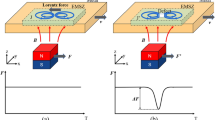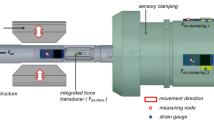Abstract
Information on the mechanical load which has been applied on a component during its lifecycle is becoming more and more interesting in order to assist the development of new generations of lightweight components. To collect this information from a large number of components in the field, cost-effective sensor techniques are required. The idea of the research presented in this paper is to qualify the base material of a component itself as a sensor. Load-induced changes in the microstructure of metastable austenitic sheet metals at the basis for this idea. Capabilities of increasing the sensitivity related to load-induced martensite phase transformations with the aid of metal forming operations as well as an approach to detect the direction of mechanical forces using embossed sensor fields are presented. The development of sensor fields based on FE-simulation as well as the results of experimental tests are discussed.









Similar content being viewed by others
References
Behrens B-A, Weilandt K (2009) Mathematical description of α′–martensite formation and its application for the detection of damage in sheet metal. In: Materials Science and Technology, pp 1485–1496
Behrens B-A, Doege E, Springub B (2004) Transformation induced martensite evolution in metal forming processes of stainless steels. Steel Res Int 75(7):475–482
Behrens BA, Weilandt K (2008) A procedure for the sensitisation of α′–martensite evolution, 4th I*PROMS virtual international conference on innovative production machines and systems
Behrens B-A, Voges-Schwieger K, Schrödter J, Jocker J (2012) Load sensitive control arm based on martensitic phase transformation. Proceedings of the 1st joint international symposium (SysInt), pp 52–55
Barenbrock D (2002) Einfluss verformungsinduzierter Martensitumwandlung auf das Rissfortschrittsverhalten austenitischer Stähle, PhD Thesis, Universität Hannover
Bassler H-J (1999) Wechselverformungsverhalten und verformungsinduzierte Martensitbildung bei dem metastabilen austenitischen Stahl X6CrNiTi1810, PhD Thesis, Technical University of Kaiserslautern
Weiss A, Eckstein HJ (1990) Martensitbildung in korrosionsbeständigen Stählen. Korrosionsbeständige Stähle, Deutscher Verlag für Grundstoffindustrie GmbH, pp 89–98
Kranz SW (1999) Mechanisch-technologische Eigenschaften metastabiler austenitischer Edelstähle und deren Beeinflussung durch TRIP-Effekt, PhD-Thesis, Technical University of Aachen
Ludwigson DC, Berger JA (1969) Plastic behaviour of metastable austenitic stainless steels. J Iron Steel Inst 207:63–69
Smaga M (2005) Experimentelle Untersuchung der Mikrostruktur sowie des Verformungs- und Umwandlungsverhaltens zyklisch beanspruchter metastabiler austenitischer Stähle, PhD Thesis, Technical University of Kaiserslautern
Angel T (1954) Formation of martensite in austenitic stainless steels. J Iron Steel Inst 165–174
Hänsel A-H-C, Hora P, Reissner J (1998) Model for the kinetics of strain-induced martensitic phase transformation at non isothermal conditions for the simulation of sheet metal forming processes with metastable austenitic steels. Simulation of Materials Processing: Theory, Methods and Applications, Rotterdam
Khan Z, Ahmed M (1996) Stress-induced martensitic transformation in metastabile austenitic stainless steels: effect on fatigue crack growth rate. J Mater Eng Perform 5(2):201–208
Choi JY, Won Jin (1997) Strain induced martensite formation and its effect on strainhardening behavior in the cold drawn 304 austenitic steels. Scr Mater 36(1):99–104
Kamp M (2008) Nutzung der spannungs- und verformungsinduzierten Martensitbildung zum Nachweis mechanischer Belastungen an lokal umgeformten metastabilen austenitischen Edelstahl X5CrNi18-10, PhD-Thesis, Universität Hannover
Weilandt K (2011) Experimentelle und numerische Untersuchungen zur Martensitbildung unter quasistatischer und zyklischer Belastung, PhD Thesis, Leibniz Universität Hannover
Tsuta T, Cortes R-J-A (1993) Flow stress and phase transformation analyses in austenitic stainless steel under cold working, Part 2. JSME Int J 36:63–72
Springub B (2006) Semi-analytische Betrachtung des Tiefziehens rotationssymmetrischer Bauteile unter Berücksichtigung der Martensitevolution, PhD Thesis, Universität Hannover
Behrens B-A, Voges-Schwieger K, Weilandt K, Schrödter J, Jocker J (2011) α′–martensite formation and a new method for the detection of damages in sheet metal components. Proceedings of the 7th European stainless steel conference science and market
Wolfram W (2002) Zerstörungsfreie Prüfung dickwandiger austenitischer Rohre und Rohrbögen mit fortschrittlicher Wirbelstromtechnik, PhD Thesis, Universität Hannover
Reimche W, Bach Fr-W, Zwoch S, Stahlhut C, von der Haar C, Kallage P, Herzog D, Haferkamp H (2009) Eddy current technology—a new procedure for the detection of zero-gap grooves during laser welding. Weld Cut 8(6):359–364
Zergoug M, Lebaili S, Boudjellal H, Benchaala A (2004) Relation between mechanical microhardness and impedance variations in eddy current testing. NDT E Int 37:65–72
Weber W, Feiste KL, Siebert G, Reimche W, Stegemann D, Lucht B (2000) Remote field eddy current technique for the inspection of thick walled austenitic pipes. Proceedings of the 2nd international conference on NDE in relation to structural integrity for nuclear and pressurized components, Palo Alto USA, pp B203–B218
Reimche W, Duhm R, Zwoch S, Bernard M, Bach Fr-W (2006) Development and qualification of a process-oriented nondestructive test method for weld joints to operate with remote field eddy current technique. NDT E Int 11(11):1435–4934
Mroz G, Reimche W, Bach Fr-W (2012) The use of components edge region as inherent information carriers and loading indicators, 1st CIRP conference of surface integrity (CSI), pp 158–160
Acknowledgments
The authors would like to thank the German Research Foundation (DFG) for funding the Collaborative Research Centre CRC 653. The work presented within this paper was part of the CRC Subprojects S2 and S3.
Author information
Authors and Affiliations
Corresponding author
Rights and permissions
About this article
Cite this article
Behrens, BA., Maier, H.J., Bach, FW. et al. A method to detect the level and direction of mechanical forces with the aid of load-induced martensitic phase transformation. Prod. Eng. Res. Devel. 8, 63–72 (2014). https://doi.org/10.1007/s11740-013-0513-z
Received:
Accepted:
Published:
Issue Date:
DOI: https://doi.org/10.1007/s11740-013-0513-z




